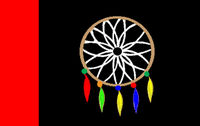Utawia

| |
| Subdivision of: | North American League |
| Cities: | |
| Capital: | Detroit |
| Largest: | Detroit |
| Other: | Singapore, Fort Michillimakinac |
| Languages: | |
| Official: | English, Algonquin |
| Others: | French (in cities of Detroit and Fort Michillimakinac) |
| Lord Governor: | |
| Admission to NAL: | 1877 (29th) |
Government
Utawia's single-house provincial legislature has two names--the Senate and the Council Fire, although both describe the identical body. A total of 119 Senators are elected. Nine of them are "at large," that is, elected by the province as a whole. The rest represent Counties, two each for the sixty counties that make up the province.
Executive authority lies in the provincial Cabinet or Circle of Chiefs, consisting of three Chiefs elected by the Senate, three in an "at large" election and three chosen by the Circle itself from among former Senators or Judges. The Chair of the Cabinet, or "First Chief," is generally referred to as the Lord Governor. This position shifts in three-year-terms (the Cabinet members serve for nine years each).
Judges on the County level are elected for terms ranging from four to twelve years. The Supreme Court of the province is a seven-member body whose members serve for life. They are nominated by the Circle of Chiefs and confirmed (or not) by the Council Fire.
History
Utawia was home to various Native Americans centuries before colonization by Europeans. When the first European explorers arrived, the most populous and influential tribes were Algonquian peoples - specifically, the Ottawa, the Anishnabe (called "Chippewa" in French, after their language, "Ojibwe"), and the Potawatomi. The Anishnabe were the most populous, estimated at between 25,000 and 35,000 within Utawia, where they were located throughout in the Upper Peninsula and northern Lower Peninsula. The Anishabe also lived in Ontario and northern Ouisconsin. The Ottawa lived primarily south of the Straits of Mackinac in northern and western Utawia, while the Potawatomi were primarily in the southwest. The three nations co-existed peacefully as part of a loose confederation called the Council of Three Fires. Other First Nations people in Utawia, in the south and east, were the Mascouten, the Miami, and the Wyandot, who are better known by their French name, "Huron".
Utawia was explored and settled by French voyageurs in the 17th century. The first Europeans to reach what later became Utawia were Étienne Brûlé's expedition in 1622. The first European settlement was made in 1641 on the site where Father (or Père, in French) Jacques Marquette established Sault Sainte-Marie in 1668.
Saint-Ignace was founded in 1671, and Marquette in 1675. Together with Sault Sainte-Marie, they are the three oldest cities in the region. "The Soo" (Sault Ste. Marie) has the distinction of being the oldest city in both Mascoutensi and Ontario. Officially, Sault Sainte-Marie is still one city caught between two provinces, but administratively the two halves function rather independently of each other and are each responsible to the local governments of Utawia and Ontario respectively.
In 1679, Lord La Salle of France directed the construction of the Griffin, the first European sailing vessel on the upper Great Lakes. That same year, La Salle built Fort Miami at present-day St. Joseph.
As the XIXth century progressed, the Northern Provinces of the NAL saw an upsurge of immigrants, mostly from Europe, looking for land and opportunity. In Utawia as well as other provinces, ethnic and religious conflicts broke out, culmunating in the Crisis of 1875.
Culture
Like many NAL provinces, Utawia is essentially a hybrid culture, with the ethnic European majority having adopted many Ottawa, Potawatomi and Ojibwe ways. Likewise, the Native Tribal Peoples have been heavily influenced by the influx of Europeans. This shows perhaps mostly in the prevalance of Christianity. The Tribal influence shows up most obviously in the relative scarcity of neckties, even at formal or legal events.
Utawia is the home of several major Basketball teams including the Detroit Royals and Marquette Vipers.
Like many Northron Provinces, Utawia is a rich source of legend about the period when it was a frontier. Tales of ghost towns, of conflicts between Europeans and Natives, as well as regions where (for a time) there were far more people than legal institutions abound, forming the basis of a thriving genre in literature and other media. Several ghost towns have actually been bought up and turned into tourist attractions, exploiting this perception.
| This article is source material
|
- Considered a "Native" province.
- Joined NAL in 1877 (after Ouisconsin in 1835 but before Mascoutensi in 1883).
- City of Detroit contain Mormon temple.
- Includes the city of St. Ignace, presumably based upon the city of the same name in real-life Michigan.
- The "u" is hardly or barely pronounced.
- The accent is on the first "a". "(u)-TA-wah". The name is based on the Ottawa (also Odawa, or Odaawaa) tribe (meaning "traders") related to but distinct from the Ojibwe nation. The Ottawa and Ojibwe were part of a long term alliance with the Potawatomi tribe, called the Council of Three Fires.